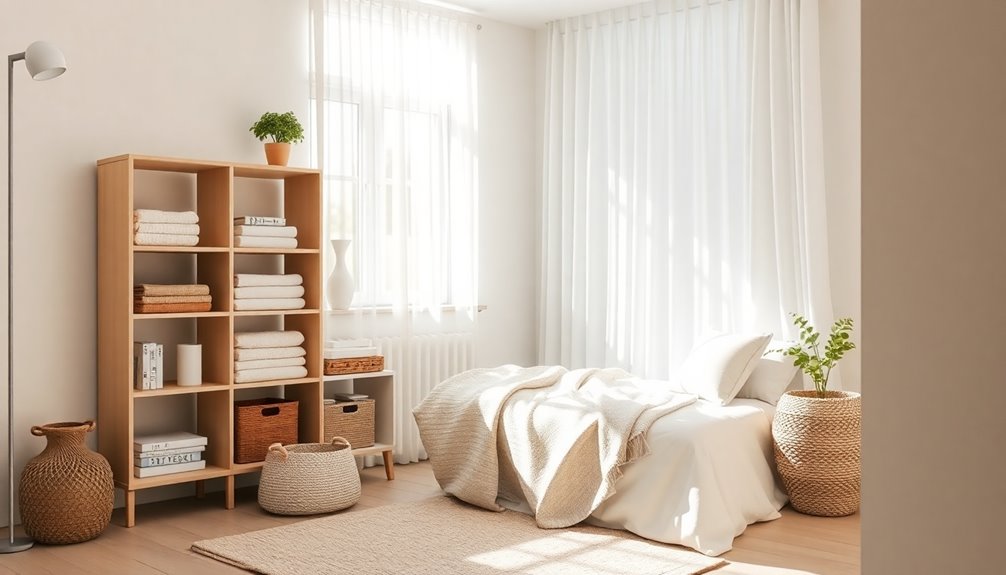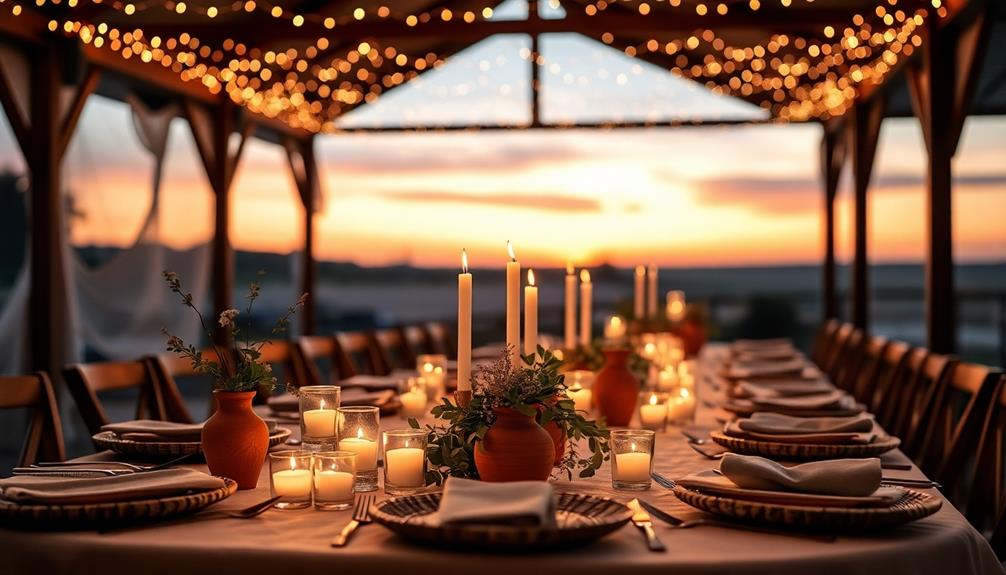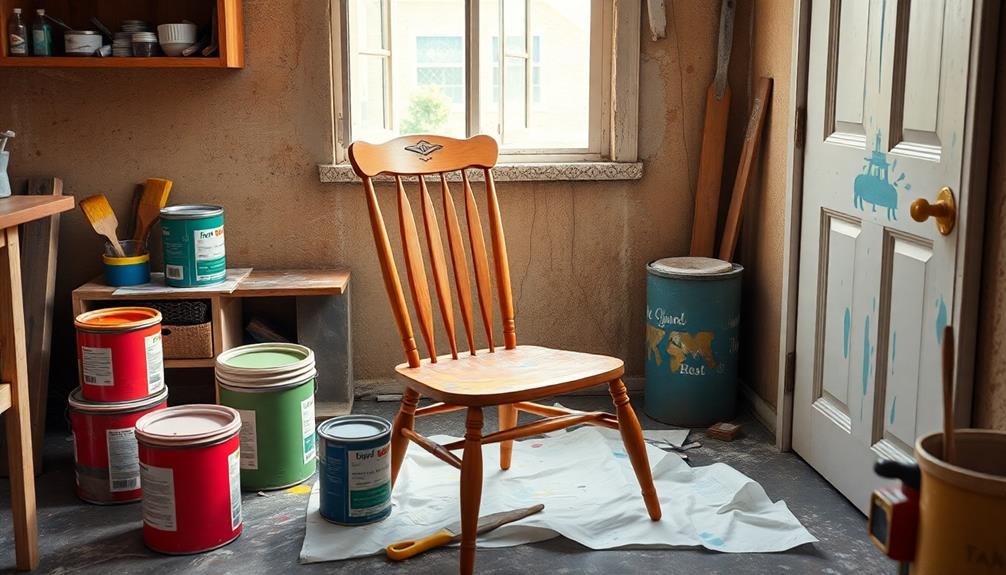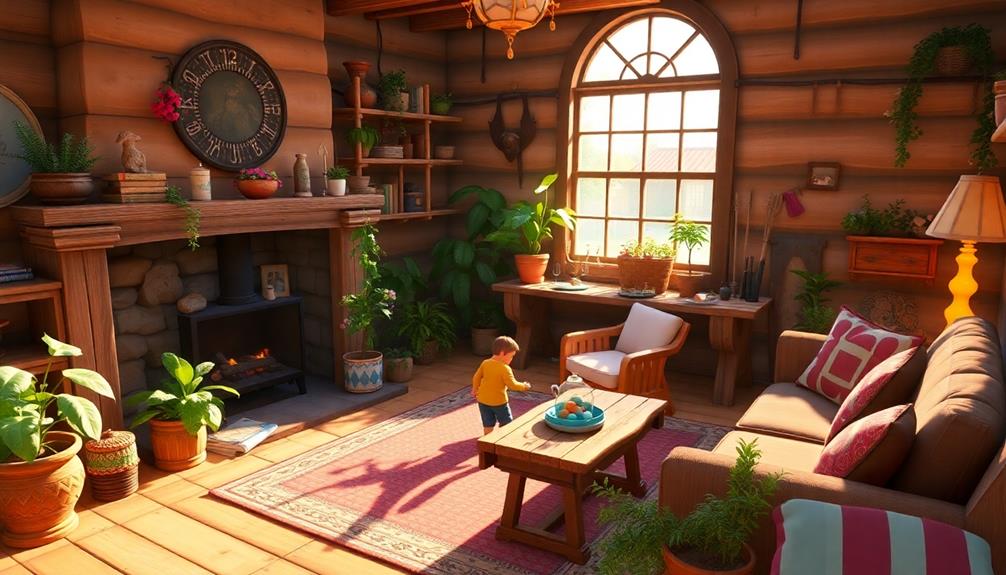To declutter your small space using Nordic organization principles, start by embracing minimalism. Assess your belongings with the Keep, Toss, Donate method, keeping only what you truly use and need. Take advantage of multifunctional furniture and vertical storage to maximize space. Group similar items together and label containers for easy access. Regularly establish routines to maintain organization, and consider the Lagom philosophy—aiming for balance and simplicity. Lastly, create a cozy ambience that encourages mindfulness and relaxation. There's a lot more to discover on how to make your space both functional and inviting.
Key Takeaways
- Embrace Scandinavian design by using multifunctional furniture to maximize space efficiency and minimize clutter in small areas.
- Implement vertical storage solutions like wall-mounted shelves to utilize vertical space and keep floors clear.
- Categorize belongings by grouping similar items and using labeled containers for easy access and organization.
- Adopt a minimalism mindset by regularly purging non-essential items and focusing on functionality in decor choices.
- Create a cozy atmosphere with natural materials and soft lighting to enhance the overall aesthetic while maintaining organization.
Embracing Minimalism
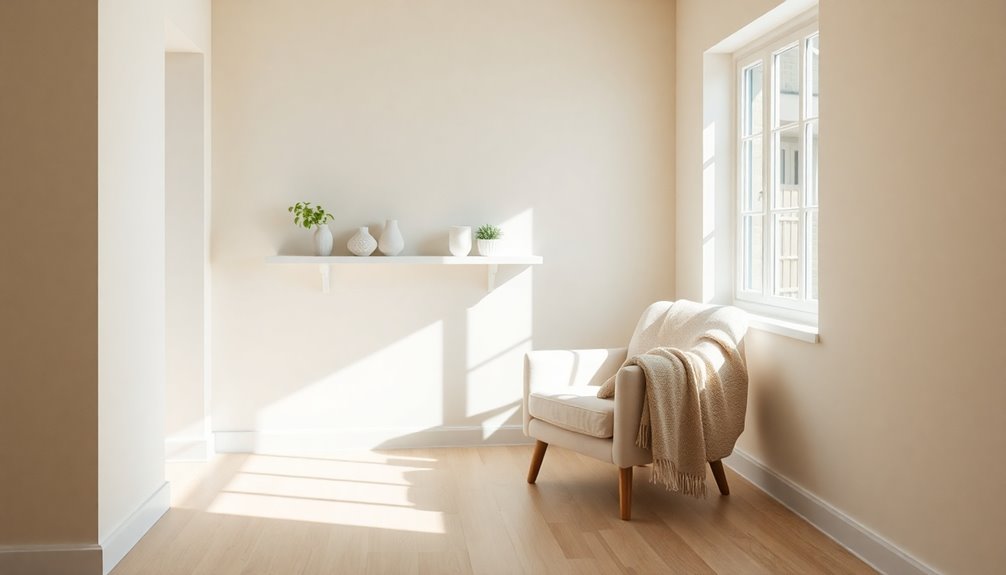
Embracing minimalism is all about creating a space that serves you, not the other way around. You'll find that functionality is key in your home. Every item you keep should have a purpose and be something you genuinely love. This means focusing on practical pieces rather than mere decorations.
By maximizing your space with only essential items, you encourage a mindful selection of possessions, ultimately reducing clutter.
Simplicity and organization are crucial in achieving this goal. Minimize clutter to create a clean, organized environment. Utilize simple solutions like trays, boxes, and baskets to keep everything in its place.
Clean lines and a neutral color palette enhance the simplicity and help maintain that desired clutter-free aesthetic. Regular decluttering is essential to keep your space feeling open and inviting. Incorporating natural elements can further elevate your minimalist approach. Introduce materials like wood, wool, and stone into your home, along with plants for a calming effect.
Emphasizing natural sunlight and soft lighting fosters harmony. By embracing minimalism, you not only create a beautiful space but also cultivate a lifestyle centered around purpose and intentionality.
The Keep, Toss, Donate Method
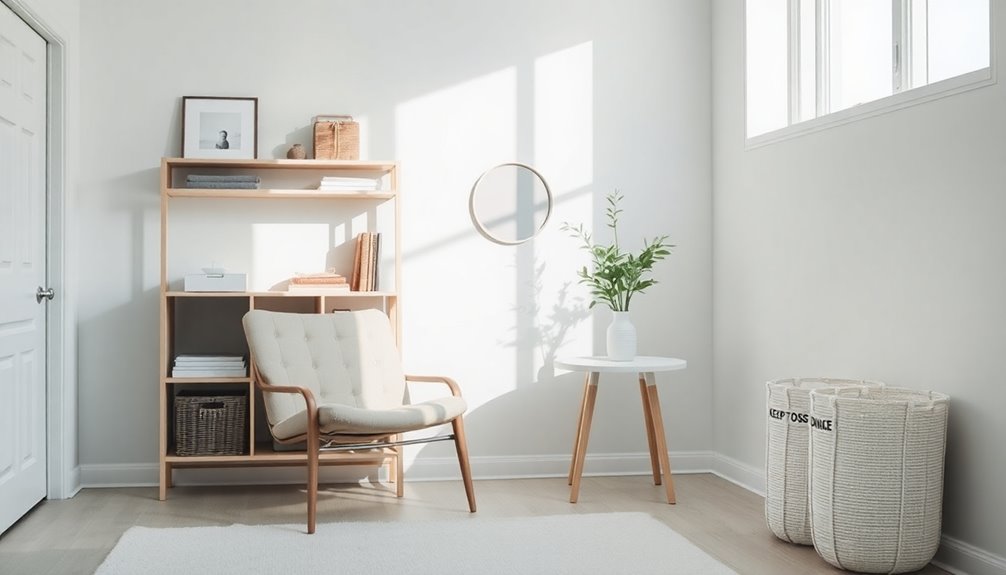
When it comes to decluttering, the Keep, Toss, Donate Method offers a straightforward way to streamline your decision-making process.
Start by assessing each item based on usage; if it hasn't been used in over a year, it's likely time to toss or donate it. For items that you love and use, those are keepers. However, if they're neither loved nor used, consider letting them go.
Next, examine the condition. Keep items that are functional and complete, while tossing those that need major repairs or are expired. Duplicates can be a sign that some items can go, so don't hesitate to part with extras.
Create separate piles for keeping, tossing, and donating. It's often easier to start with less sentimental items before tackling those you feel attached to. Remember that the importance of practicality can help you make quicker decisions during this process.
Remember to respect your time; use donation centers that accept a variety of items to simplify the process.
Lastly, think about the emotional cost of keeping items versus the benefits. If you wouldn't replace an item if it were lost, it might be time to say goodbye.
Scandinavian Design Principles
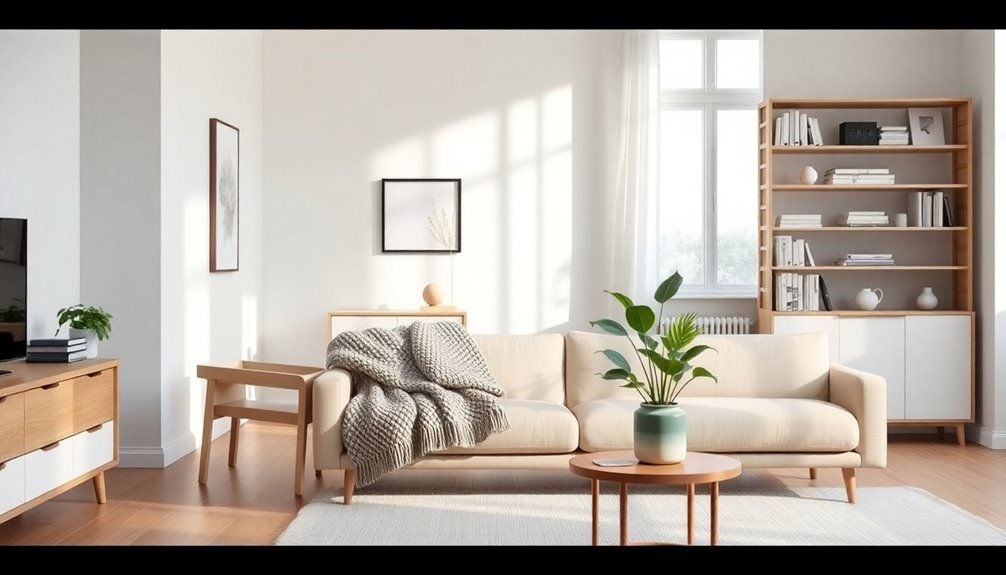
Scandinavian design principles focus on creating spaces that prioritize functionality and simplicity. Embracing a 'less is more' mindset, you'll reduce clutter by concentrating on essential items. Keep your spaces free from unnecessary objects to maintain openness and functionality, which fosters a calming atmosphere. Minimalism is more than a design trend; it's a lifestyle choice that emphasizes thoughtful consumption.
Integrating natural elements into your space connects you with nature. Use materials like wood, stone, and wool, and incorporate plants to breathe life into your home. This design approach emphasizes the use of natural materials to create a harmonious living environment.
Maximize natural light with large windows and light-colored walls, and choose eco-friendly materials to show respect for the environment. Functionality and practicality are key. Select furniture that serves a specific purpose and is multifunctional. Incorporating sustainable art deco furniture options can add a touch of elegance while ensuring that your home reflects your commitment to environmental sustainability. Look for pieces that combine intricate designs with durable, eco-friendly materials, allowing you to achieve a stylish yet conscientious aesthetic. By carefully curating your space with both functionality and sustainability in mind, you can create an inviting atmosphere that honors both form and function.
Invest in high-quality pieces that combine form and function, and utilize innovative storage solutions to keep everything in order. Ensure every item has a designated place to maintain a calm environment.
Categorizing Your Belongings
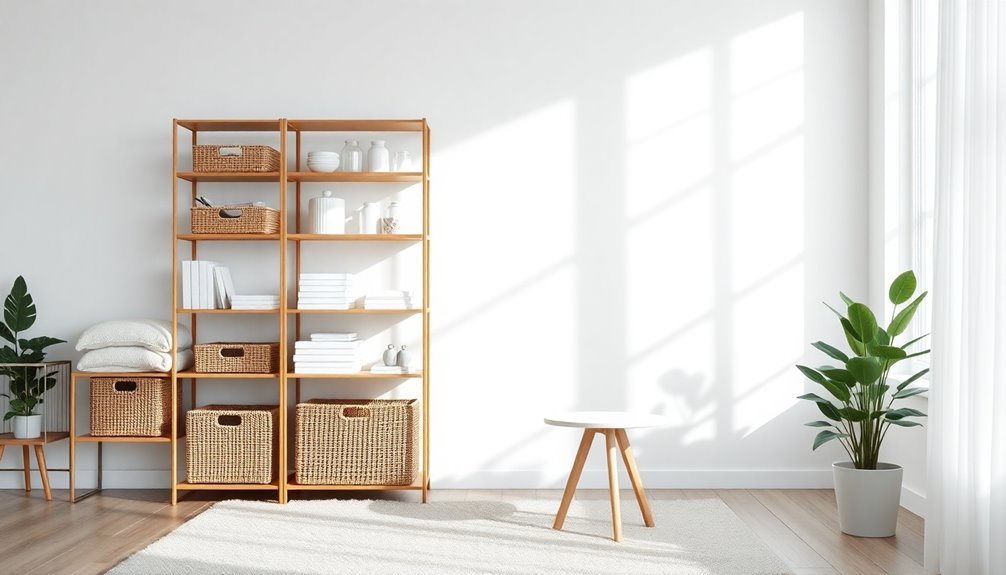
Categorizing your belongings is a crucial step in the decluttering process that can make a significant difference in how you manage your space. Start by grouping similar items together, which helps you identify duplicates and simplifies decision-making.
Separate your essentials from non-essentials, and be honest about what's truly necessary to keep. Additionally, digital creativity can enhance your decision-making skills during this process by encouraging innovative ways to sort and organize your items.
Next, categorize items by how often you use them. Store frequently used items in easily accessible locations. Use labeled containers for sorting items into categories like keep, donate, recycle, and discard. This makes the decluttering process more efficient. Additionally, consider utilizing vertical space to store items that you don't use as often, which can free up valuable floor space.
Consider the purpose of each item and ask yourself if it still serves a function in your life.
When decluttering, tackle one room at a time to prevent feeling overwhelmed. Focus on specific areas within each room, like nightstands or kitchen cabinets.
As you categorize, think about your storage needs; utilize vertical space, door backs, and clear containers to maximize organization.
Lastly, maintain your newly organized space by developing daily habits, like putting items away immediately and resetting your space to keep clutter at bay.
Sorting Strategies for Small Spaces
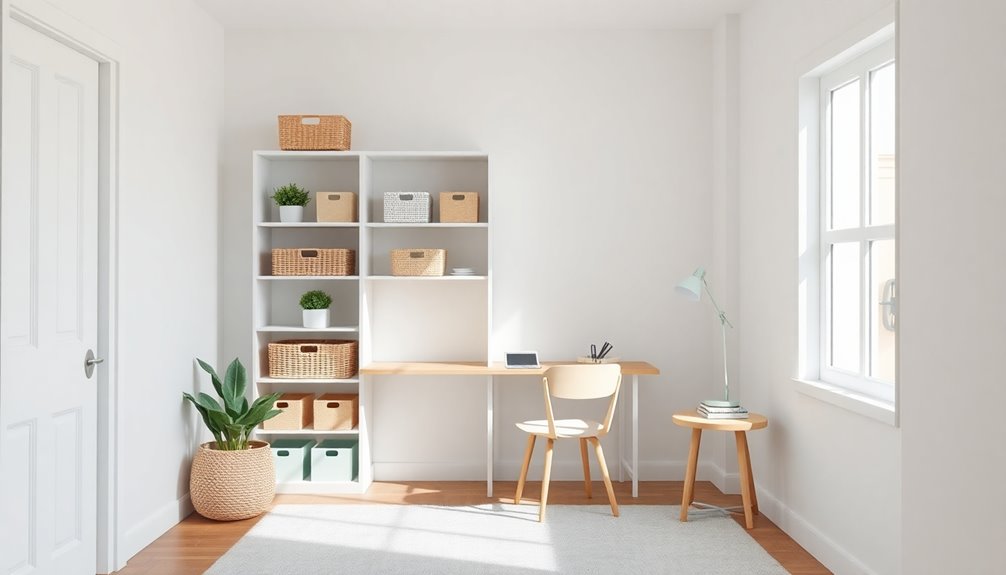
To maximize your small space effectively, you need to adopt smart sorting strategies that make organization a breeze. Start by utilizing vertical space; install shelves and hooks on walls or above doors to free up floor space.
Consider bunk beds or vertical shelving units in bedrooms to optimize storage. Mount pegboards for craft supplies, and incorporate command hooks for hanging bags and tools. Implementing these strategies can also help you reduce stress by creating a peaceful and organized home environment. Moreover, using vertical storage solutions can significantly enhance your efficiency by maximizing available space.
Creating distinct zones in multi-purpose rooms is crucial. Divide areas using furniture arrangements, cubby hole storage units, or even different wall colors to define spaces for work, relaxation, or hobbies.
Rolling carts can serve as movable zones for added flexibility.
Don't forget about hidden and overlooked spaces. Use the backs of doors for organizers, and install closet systems to maximize storage.
Under beds, employ risers or bins for extra storage. In the kitchen, spinning organizers like lazy susans can keep spices and condiments tidy.
Daily Decluttering Practices
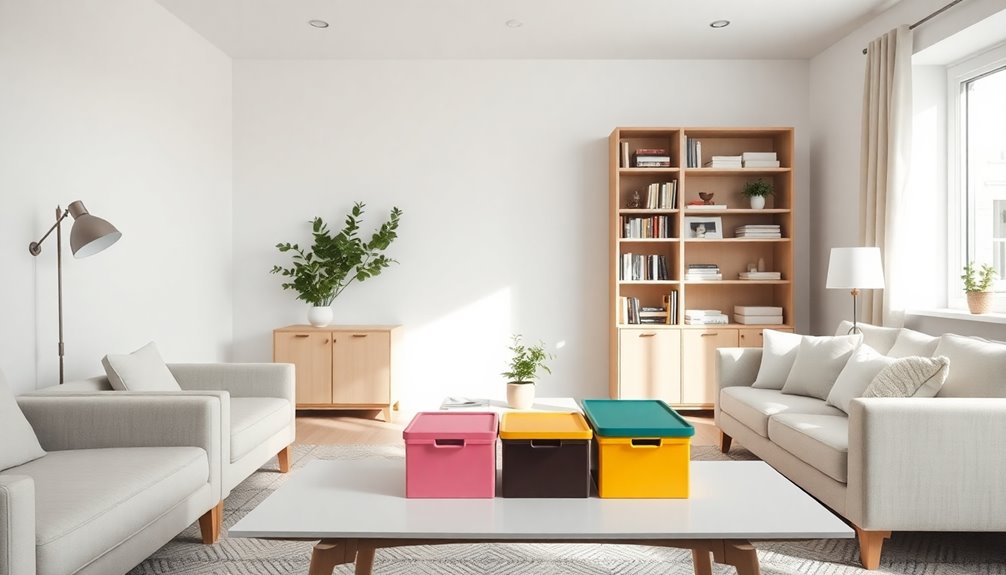
After implementing effective sorting strategies, it's time to establish daily decluttering practices that keep your space organized. Start by spotlighting one specific area of your home each week, whether it's a closet, drawer, or corner. This focused approach helps manage clutter effectively.
Don't forget to tackle paper! Regularly review and recycle old magazines, newspapers, and mail to maintain a clean visual space.
Next, consider a digital detox. Organize your files, delete unnecessary emails, and sort through digital clutter to create a tidy online environment. Engage in a donation drive by regularly assessing your belongings and donating items you no longer need.
Set aside a 2-3 hour block each week dedicated solely to decluttering. Breaking larger tasks into smaller, manageable chunks can help maintain a minimalist lifestyle as you avoid feeling overwhelmed. Follow a 31-day decluttering challenge with specific daily tasks to keep your momentum going.
Remember to create a schedule for decluttering. Clear a working space, start from one side of the room, and sort items into keep, donate, or discard piles.
Efficient Storage Solutions
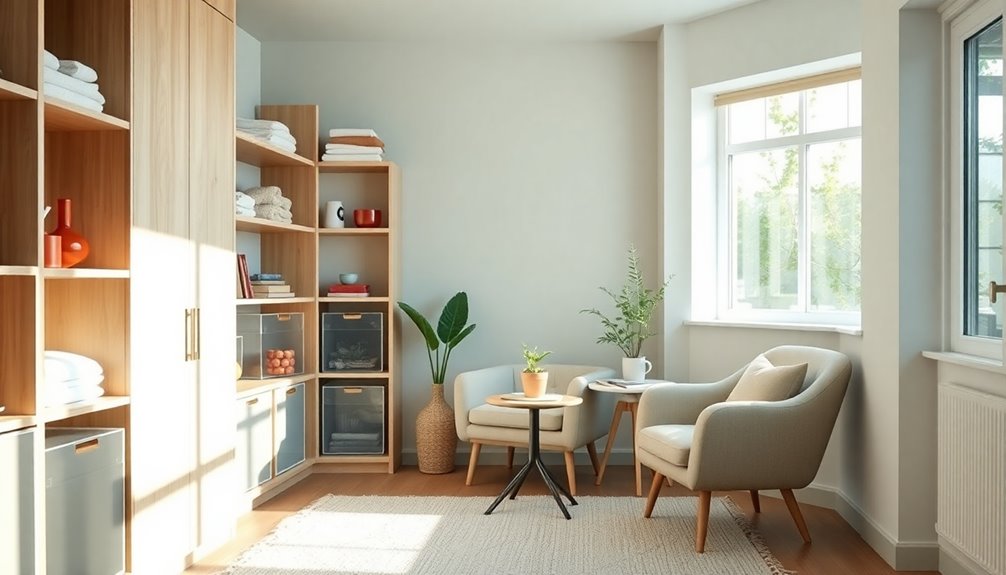
Efficient storage solutions can transform small spaces into organized havens. By utilizing vertical storage, you can open up areas like your kitchen, making them feel more expansive. Install wall-mounted shelves or corner shelves to maximize those tricky empty spots between furniture and walls.
Don't forget about closets—tall, skinny accessory shelves can help you utilize vertical space effectively. Wall storage solutions prevent additional floor clutter, maximizing vertical space in your home.
Hidden and disguised storage is another smart approach. Consider incorporating furniture like the Swing Chaise, which offers a hidden storage compartment beneath the seat. Closed storage units that blend with your walls keep visual clutter at bay.
You can also repurpose vintage furniture into standalone storage, like a coffee station with concealed compartments.
Look into narrow and modular storage options, such as Shallow Base Units in tight hallways. Modular closet systems help you make the most of available wall space.
Open and combination storage can showcase your belongings while keeping things organized. Use open shelves and rails to display items neatly, while combination units can hide some items in boxes or drawers.
With these efficient storage solutions, you'll maximize your small space and enjoy a clutter-free environment.
Multi-Functional Furniture Ideas
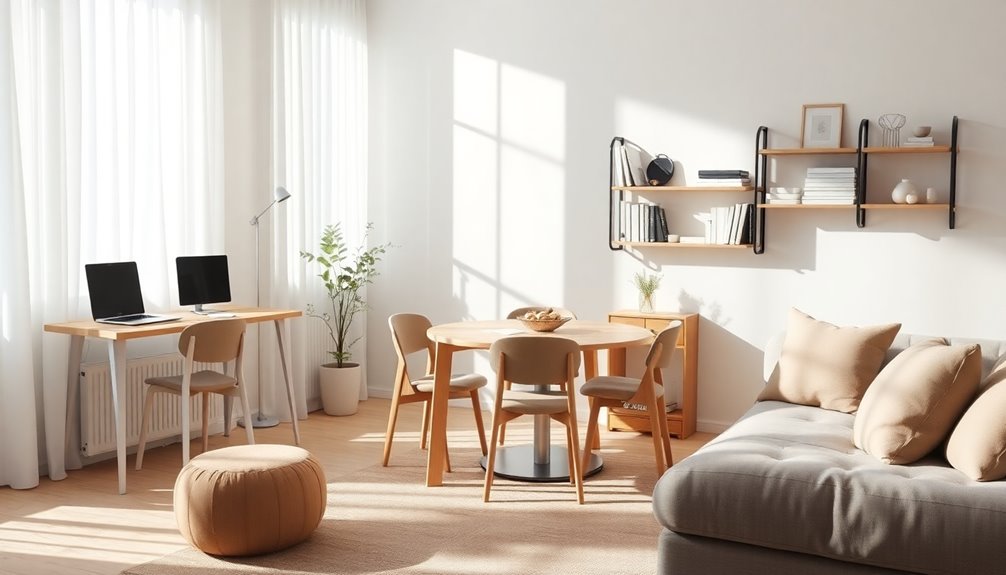
Maximizing your small space often hinges on the clever use of multi-functional furniture. Consider a bed and desk combination, like the Majestic from Hiddenbed. It integrates a queen-sized bed with a writing desk, providing under-bed storage and shelves. The increasing trend of urban living means more people are seeking solutions that fit within limited square meters.
Transforming tables can also save space; these pieces shift from coffee tables to dining tables, accommodating various activities. Wall beds with desks, such as the Adam Tavolo from Clei, open up to a fold-down workspace, perfect for compact rooms. Look for bench seats with built-in storage to serve as seating and sleeping areas while keeping clutter at bay.
Modular sofas offer flexibility, allowing you to reconfigure them based on your needs. Innovative storage solutions like foldable bookshelves expand when needed, maximizing wall space. Consider hidden storage options, like the Friheten sofa from IKEA, which doubles as a bed and has storage underneath.
Compact seating, such as the Pick Chair by Studio Dror, transforms from wall art to functional seating. These multi-functional pieces not only enhance your space but also adapt to your lifestyle, making small living more manageable.
Maintaining Order and Cleanliness
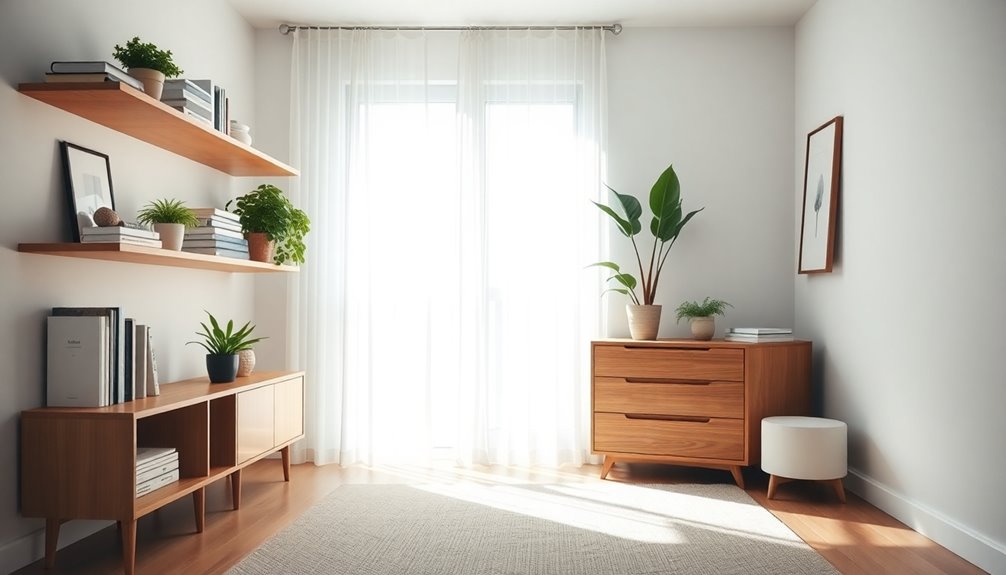
Regularly maintaining order and cleanliness in your small space can significantly enhance your living experience. Adopting a minimalist mindset is key; focus on the 'less is more' philosophy to appreciate your essential items. One way to achieve this is by ensuring that your home systems, such as heat pumps, are efficient and reliable, which contributes to an overall organized environment.
Make sure everything has a designated space, so you can keep clutter at bay. Use organizational tools like pretty boxes and trays to corral small items, and baskets for those things that don't need to be on display.
Repurpose furniture, such as a bar cart, to store appliances out of sight, or employ hanging totes to maximize vertical space. Incorporating multifunctional furniture is essential in Scandinavian design, as it allows for efficient use of limited space while maintaining a clean aesthetic.
Creating a hygge-inspired environment fosters comfort and relaxation. Store big fluffy blankets in baskets and keep candles neatly arranged to enhance the atmosphere.
Daily maintenance habits are crucial. Pick up after yourself each day to prevent clutter from accumulating. Keep frequently used items within easy reach, and avoid leaving junk mail or coats out of place.
Monthly, evaluate your space and purge unnecessary items. Using lists or reminders can help you stay organized and maintain mental clarity. Embrace these practices to enjoy a serene, tidy space.
Regular Decluttering Routines
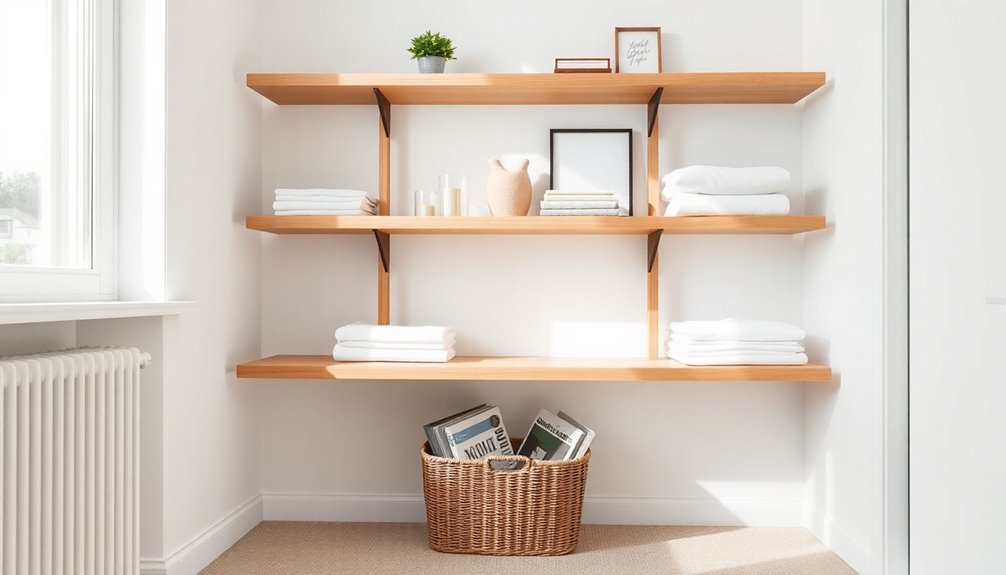
Maintaining a tidy space goes hand in hand with establishing regular decluttering routines. Schedule these sessions weekly or monthly to keep your environment organized. During each session, evaluate every item based on its usefulness and emotional value. Use the Keep, Toss, and Donate system to categorize your belongings, making decisions easier. If you haven't used an item in the past year, it's likely unnecessary.
Start with larger categories like closets and furniture, then move on to smaller items. Save sentimental items for last, as they can be the toughest to part with. Be intentional in your decluttering to avoid emotional attachment to things you don't need. Incorporating multifunctional furniture into your space can further enhance organization by providing additional storage solutions.
In addition to these sessions, practice daily maintenance to prevent clutter from accumulating. Simple tasks, like returning items to their designated places, washing dishes, and wiping down surfaces, can significantly reduce clutter.
Remember to refuse gifts or hand-me-downs you won't use to avoid adding to the chaos. By keeping up with regular decluttering and daily tidying, you'll create a streamlined, functional space that feels peaceful and organized.
The Concept of Döstädning
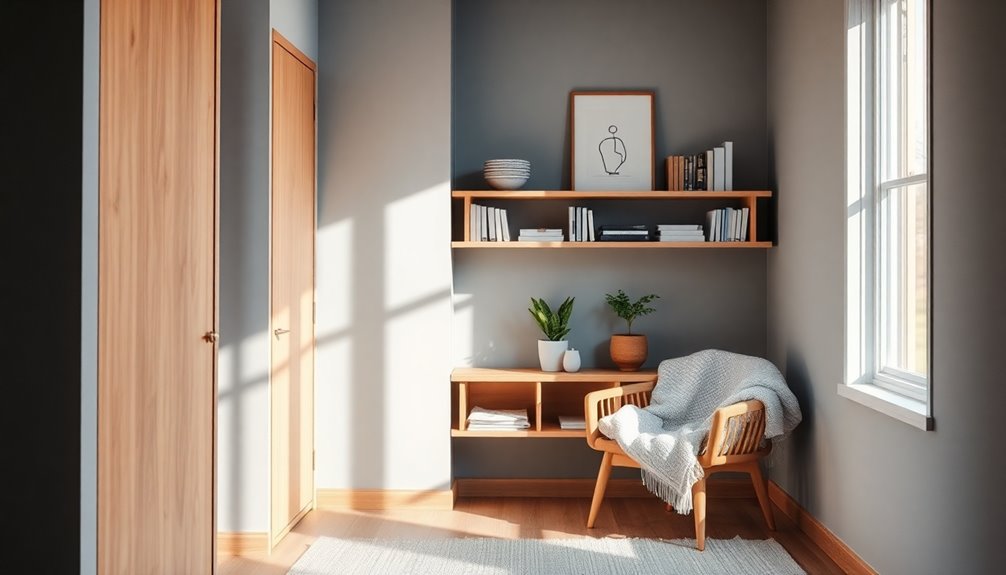
Döstädning, or "death cleaning," is a thoughtful approach to decluttering that emphasizes the importance of organizing your belongings to lighten the load for your loved ones after you're gone.
Originating in Swedish culture, this concept combines the words "dö" (death) and "städning" (cleaning), reflecting a desire for simplicity and efficiency. This ongoing process isn't meant to be rushed. Start small, focusing on less emotionally charged areas like your closet. Be honest with yourself about what items are truly significant and necessary.
Consider seeking help from family or friends—they can provide support and perspective.
By engaging in döstädning, you not only ease the burden on your loved ones but also simplify your own life. The therapeutic effects of this practice allow you to reflect on your memories while fostering a sense of peace, knowing your affairs are in order.
Plus, you can help your community by donating unwanted items, reducing waste along the way.
As you proceed, vocalize your intentions with family, treat yourself for progress made, and celebrate your achievements.
Döstädning can transform your space and mindset, offering clarity for both you and your loved ones.
Applying the Lagom Principle
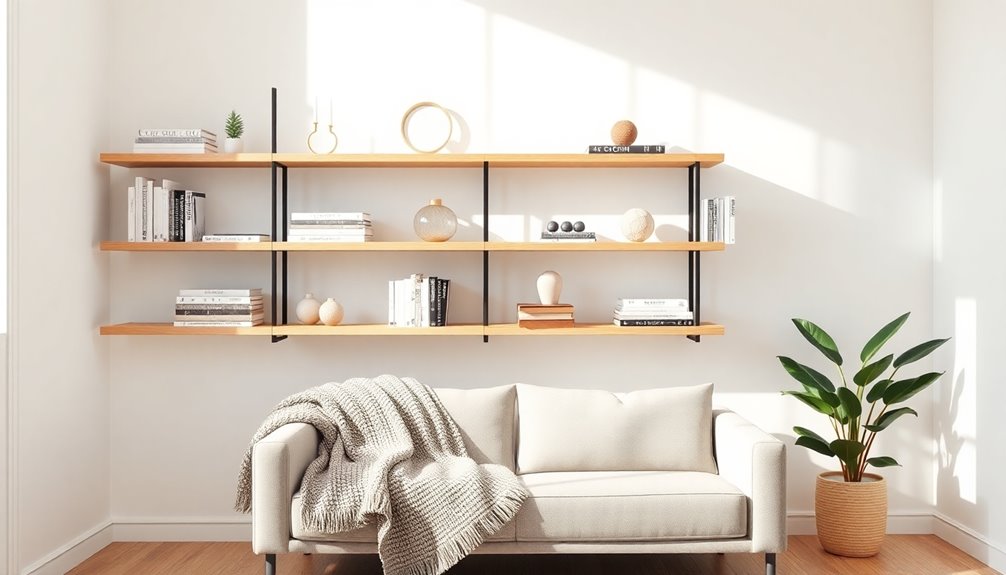
Embracing the principles of döstädning naturally leads to a more balanced approach to your living space, especially when you incorporate the Lagom philosophy.
Start by prioritizing functionality and moderation in your decor. Choose a neutral color scheme with cool, earthy tones that foster a cozy atmosphere. Focus on functional elements—select items that serve a purpose rather than novelty pieces. Keep your decor moderate; only display items that bring you joy and have meaning. This approach aligns with the principle of simplicity, emphasizing a less-is-more mindset. Modern farmhouse style also emphasizes functionality, making it a great source of inspiration for your organization efforts.
To maintain a clutter-free environment, designate specific spaces for each object and commit to regular purging. Evaluate your belongings every six months, removing anything you haven't used.
Utilize storage solutions like bins and organizers to keep items tidy, and practice daily maintenance to prevent clutter accumulation.
Creating a Hygge Atmosphere
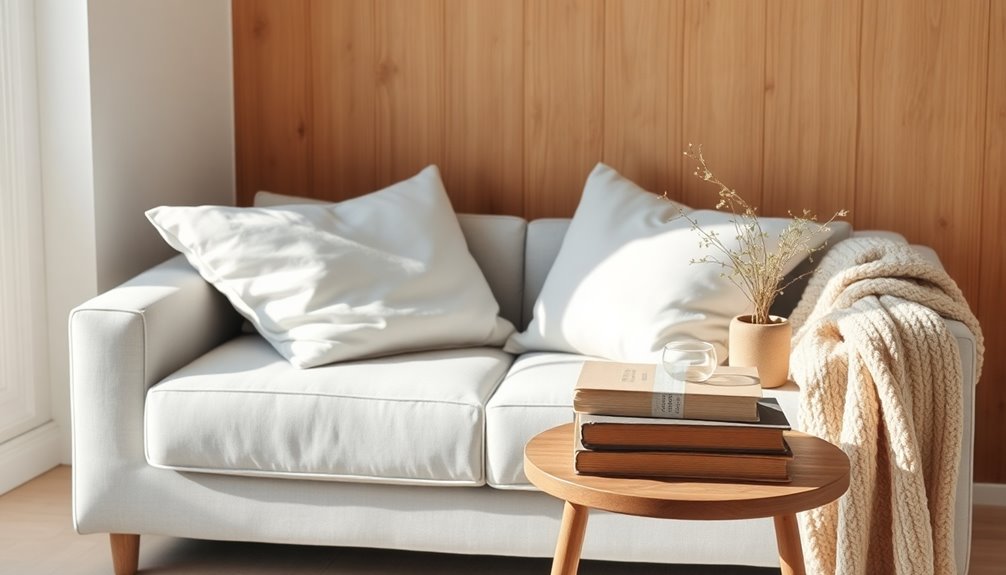
Creating a hygge atmosphere in your small space involves blending comfort and warmth to foster a sense of well-being.
Start by adjusting your lighting; ditch harsh bulbs for soft, warm sources like candles, fairy lights, or dimmable lamps. The glow from a fireplace or the soft hues of a sunset can amplify that cozy vibe.
Layer your space with plush blankets, chunky knits, and soft cushions. Choose natural materials like wool and fur to elevate comfort, and don't forget fuzzy socks and cozy pillows. Simple pleasures are essential to enjoy the cozy ambiance, so consider adding a favorite mug for your beverages. Incorporating natural materials like wood not only enhances comfort but also brings a touch of nature indoors.
Mixing different textiles, such as faux fur and linen, adds depth and warmth to your decor.
Incorporate natural elements to enhance the hygge feel. Wooden accents, pinecones, and evergreen branches can bring the outside in, while vintage or handcrafted items add a personal touch.
Lastly, focus on mindfulness and togetherness. Create a cozy nook for family gatherings and encourage everyone to unplug during meals.
Celebrate the simple joys, whether it's sipping hot cocoa or curling up with a good book. By weaving these elements together, you'll cultivate a serene and inviting atmosphere that truly feels like home.
Frequently Asked Questions
How Can I Start Decluttering if I Feel Overwhelmed?
When you feel overwhelmed, start small. Choose one area or category, set a timer for 15 minutes, and focus on that. Use the Keep, Toss, Donate system to simplify decision-making and gradually clear clutter.
What Are the Benefits of Decluttering for Mental Health?
Decluttering significantly benefits your mental health by reducing stress, enhancing focus, and boosting self-esteem. A tidy space makes you feel in control, promotes better sleep, and improves relationships, contributing to an overall happier life.
How Do I Decide What to Keep From Sentimental Items?
To decide what to keep from sentimental items, focus on personal significance. Ask yourself if each item sparks joy or holds positive memories. Let go of guilt and negativity, prioritizing what truly resonates with you.
Can I Incorporate Personal Style in a Minimalist Space?
Absolutely, you can incorporate personal style in a minimalist space. Choose a few meaningful pieces, maintain clean lines, and allow negative space to highlight your favorite items while keeping the overall look uncluttered and intentional.
What Are Some Tips for Involving Family in Decluttering?
To involve your family in decluttering, set clear goals, assign roles, and create a fun atmosphere. Use games, establish a reward system, and maintain open communication to keep everyone engaged and motivated throughout the process.
Conclusion
By embracing these decluttering strategies, you can transform your small space into a serene Nordic haven. Remember to keep it minimal, utilize the Keep, Toss, Donate method, and apply Scandinavian design principles. Regularly sorting through your belongings and adopting routines will help maintain a clutter-free environment. Embrace concepts like Döstädning and Lagom to find balance, and create a cozy, inviting atmosphere that reflects your style. Enjoy the peace that comes from a well-organized space!
